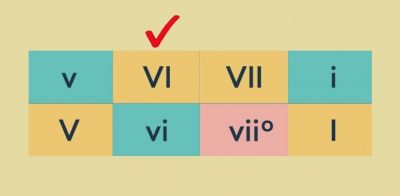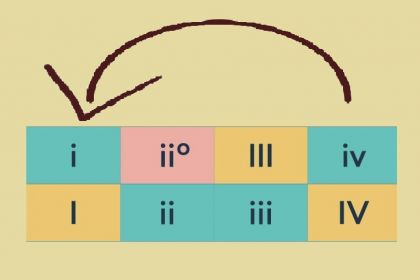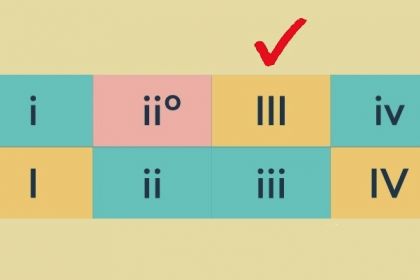Music Theory
Popular songs showing the submediant chord in all diatonic modes

Roman numerals indicating chords of minor and major scales
Genre: Rock
In musical theory, the submediant refers to the sixth scale degree of the diatonic scale, and the triad rooted in the sixth scale degree is therefore often called the submediant chord. Out of the seven diatonic scales forming the basis of their respective modes, the major submediant triad is present in the three modes: Aeolian, Phrygian, and Lydian; the minor submediant triad is found in the Ionian, Mixolydian, and Locrian modes; and the diminished mediant triad is built on the sixth scale degree in the Dorian mode.
Following the principles of harmonic analysis, chords are typically denoted by Roman numerals with capitalized numbers used for major chords and lowercase numbers reserved for minor chords. Thus, submediant chords rooted in the sixth scale degrees can be designated as VI, vi, or vi0 for a diminished chord.
Harmonic analysis postulates that all chords of a certain diatonic mode interact in the context of the three harmonic functions: the tonic, dominant, and subdominant. Depending on its position in chord progressions, the submediant chord can be attributed to both tonic and subdominant functions.
The Ionian mode, also known as the major mode, offers the most comfortable environment for applying vi submediant chords given that the starting point of the relative natural minor scale falls on the sixth degree of the major scale. In other words, the Ionian submediant chord simultaneously acts as the tonic chord of the Aeolian mode.
The psychedelic masterpiece Sugaree, composed in E Ionian by Grateful Dead's guitarist Jerry Garcia, reveals a progression of primary major chords in the verses: B–E–A–E or V–I–IV–I. The choruses add clear minority to the song as evident from the following chord chains:
- F♯m–C♯m–A–E or ii–vi–IV–I
- B–C♯m–A–E or V–vi–IV–I
- B–E–C♯m–A–E or V–I–vi–IV–I
In addition to the C♯m submediant chord, the chorus contains the F♯m minor triad rooted in the second scale degree which is often referred to as the supertonic chord.
Listen to Sugaree by Jerry Garcia:
The submediant chord is a key element of the deceptive cadences used in songs to create repetition of the last line in the verse. In instrumental music, they can be applied to further develop chord chains in order to close a particular music section. In such harmonic turnarounds, the submediant chord follows the dominant triad V–vi, thereby interrupting the authentic cadence V–I expected at the end of a music section.
A good example of the deceptive cadence that follows classical music canons can be found in the song I Will by The Beatles composed in the key of F major. Here is the harmonic analysis of the song's chord chain for each line of the verse:
- F–Dm7–Gm7–C7 or I–vi7–ii7–V7
- F–Dm–Am or I–vi–iii
- F7–B♭–C7–Dm–F or I7–IV–V7–vi–I
- Bb–C7–F–Dm7–Gm7–C7 or IV–V7–I–vi7–IV–V7
The first line ends with the dominant chord of the fifth scale degree, showing the harmonic turnaround called a half cadence and creating a sense of expectation for the tonic chord to appear which it then promptly does at the beginning of the second line. The next cadence with the dominant chord appears in the third line of the verse, where the fifth scale degree chord is resolved by the following submediant chord V7–vi. Further chord progression contains the classic cadence formula I–IV–V–I, followed by another half cadence that closes the verse in anticipation of the next section.
Listen to I Will by The Beatles:
Interesting examples of submediant chord applied in the Ionian mode can be found in The Beatles' I've Just Seen A Face and I Need You. Both harmonic analyses are outlined in the article on the Ionian mode and the major scale.
The VI major submediant chord is quite common in Aeolian mode songs where it can also be used in deceptive cadences. Chord progressions revealing the variable use of the submediant chord can be seen in Bob Dylan's All Along The Watchtower, Red Hot Chili Peppers' Dani California, The Beatles' Not A Second Time, Katy Perry's Part Of Me, Kiss' I Was Made for Loving You, Iron Maiden's The Trooper, and R.E.M.'s Losing My Religion. Harmonic analyses for the listed tracks are outlined in the article on the Aeolian mode and natural minor scale.
In Mixolydian songs, the minor submediant triad is not used often as is evident from all seven examples of the Mixolydian major mode application explored in this article as none of the songs uses submediant chords. A notable case of a chord progression featuring a submediant triad is seen in The Beatles' Long, Long, Long composed in C Mixolydian:
- C–Bb–Am–Gm–F–Bb–F or I–VII–vi–v–IV–VII–IV for the verses
- C–Gm–F–C–Gm–F–C or I–v–IV–I–v–IV–I for the verses
- Bb–F–C–Gm or VII–IV–I–v for the bridge
Here the Am submediant chord is a part of a stepwise downward movement of triads rooted in each scale degree successively, from the first to the fourth.
Listen to Long, Long, Long by The Beatles:
In the Phrygian mode, the VI major mediant triad is quite euphoniously combined with the tonic triad and the supertonic major chord, considered to be the highlight of Phrygian songs and is often referred to as the Neapolitan chord. Examples of this interaction are found in David Bowie's Space Oddity, Booker Ervin's Warm Canto, Tame Impala's New Person, Same Old Mistakes, and Beyoncé's I Care. The harmonic analysis can be seen in the article on the Phrygian mode and Neapolitan chord.
Fine examples of Lydian mode songs, including Fleetwood Mac's Landslide, R.E.M.'s Man on the Moon, and Steve Porcaro's Human Nature written for Michael Jackson, that use sixth-degree chords are analyzed in this article explaining the Lydian mode.
The fact that the vi0 submediant triad in the Dorian mode is a diminished chord virtually eliminates its use in popular music where diminished chords are generally not introduced.
Of all seven diatonic scales, only the Locrian scale contains the interval of a diminished fifth which divides the first and fifth scale degrees. This means that the tonic triad of the Locrian mode is a strongly dissonant diminished chord that cannot provide a stable tonic function, making the Locrian mode mostly theoretical.



